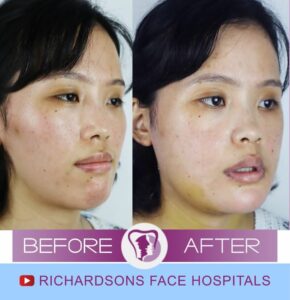2 Things You Must Know About Underbite Jaw Surgery in India
An underbite, clinically known as a Class III malocclusion, can be defined as a condition when an individual’s lower teeth overlap their upper teeth. A patient’s underbite could be a mild misalignment or a significantly pronounced underbite, which could be due to a protrusion of the lower jaw. Some of the issues patients could face with an underbite include speaking issues, difficulty while eating, chronic jaw or joint pain, cracked teeth, sleep apnea, snoring, tooth decay, chronic mouth bleeding, and emotional stress.
If you’re planning to get underbite jaw surgery in India, visit the Richardsons Dental and Craniofacial Hospital. Our founder, Dr. Sunil Richardson, is one of India’s most experienced and reputed medical professionals performing underbite surgery or jaw surgery. Whether you’re looking for details about jaw surgery to correct underbite or underbite jaw surgery cost, reach out to us, and our team members will give you all the crucial information you require.
When Do You Need A Jaw Surgery to Correct An Underbite?
The answer to gaining a lifetime of stress-free smiles is achieved through an underbite jaw surgery. A patient’s minor underbite can sometimes be taken care of through just appliances and braces. In serious cases, however, one needs the skills and assistance of a reputed oral surgeon. When your lower teeth extend out in front of your upper teeth, that is when you know that you require surgery to correct it. An underbite surgery procedure not only corrects medical issues but also improves your outer appearance, which in turn helps boost your confidence and does away with any mental stress you could have been experiencing due to the underbite.

Types of Underbite Jaw Surgery in India
If your underbite is because your jaw is sticking out much further than normal, your dentist might ask you to get an underbite jaw surgery. There are two types of underbite surgery procedures: orthognathic jaw surgery and le fort III osteotomy.
In orthognathic jaw surgery, your lower jawbone is moved to fix your protruding jaw.
During this surgery, an oral and maxillofacial surgeon works on separating the bone in the jaw’s rear part from the front aspect, after which they modify it. This allows the part of the jaw carrying the lower teeth to be repositioned properly. Such a surgery could require the patient to be hospitalised for a brief period or an outpatient surgery. It could take about 9 to 12 months to heal from this surgery, but the patient can go back to work or attend school after one to three weeks.
For a le fort III osteotomy, an oral and maxillofacial surgeon moves a patient’s entire face forward. This surgery is done when an individual’s face has sunk in above the lower jaw, thereby modifying their features and appearance.

